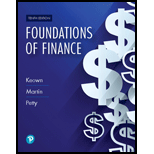
Case summary:
It’s been 2 months since individual X took a position as a collaborator budgetary examiner at C Items. In spite of the fact that your boss has been satisfied with his work, he is still a bit reluctant almost unleashing individual X without supervision. Individual X's other task includes both the calculation of money streams related to a modern venture beneath thought and the assessment of a few commonly select ventures. Given individual X's need for residency at C, y have been asked not as it were to supply a suggestion but too to reply to a number of questions pointed at judging his understanding of the capital budgeting handle. We are considering the presence of an unused item. As of now, we are within the 21 percent minimal charge bracket with a 15 percent required
To determine: The manner in which sunk cost affect the determination of cash flows.
Want to see the full answer?
Check out a sample textbook solution
Chapter 11 Solutions
Foundations Of Finance
- Please help me with this , with tge store name puebleo in St. Thomas US virgin islandsarrow_forwardI would like to expand pueblo in S5. Thomas virgin islands to Spain. Please help with an analysis expansion.arrow_forwardPlease help me with this, guidelines for the super market pueblo in St. Thomas US virgin islandsarrow_forward
- Need the below table filled out for Short-term debt %, Long-term debt $,%, Common equity $,% and Total capital $,%. Market Value Capital Structure Suppose the Schoof Company has this book value balance sheet: Current assets $30,000,000 Current liabilities $20,000,000 Notes payable 10,000,000 Fixed assets 70,000,000 Long-term debt 30,000,000 Common stock (1 million shares) 1,000,000 Retained earnings 39,000,000 Total assets $100,000,000 Total liabilities and equity $100,000,000 The notes payable are to banks, and the interest rate on this debt is 11%, the same as the rate on new bank loans. These bank loans are not used for seasonal financing but instead are part of the company's permanent capital structure. The long-term debt consists of 30,000 bonds, each with a par value of $1,000, an annual coupon interest rate of 6%, and a 15-year maturity. The going rate of interest on new long-term debt, rd, is 12%, and this is the…arrow_forwardNed assistance with Q3 and Q4 below? Cost of Equity The earnings, dividends, and stock price of Shelby Inc. are expected to grow at 6% per year in the future. Shelby's common stock sells for $21 per share, its last dividend was $1.00, and the company will pay a dividend of $1.06 at the end of the current year. Using the discounted cash flow approach, what is its cost of equity? Round your answer to two decimal places. 11.06 % If the firm's beta is 1.3, the risk-free rate is 8%, and the expected return on the market is 11%, then what would be the firm's cost of equity based on the CAPM approach? Round your answer to two decimal places. 11.90% If the firm's bonds earn a return of 9%, then what would be your estimate of rs using the own-bond-yield-plus-judgmental-risk-premium approach? (Hint: Use the mid-point of the risk premium range.) Round your answer to two decimal places. % On the basis of the results of parts a–c, what would be your estimate of Shelby's cost of equity?…arrow_forwardWhat monthly compounded interest rate would Second National Bank need to pay on savings deposits to provide an effective rate of 6.2%?arrow_forward
 Intermediate Financial Management (MindTap Course...FinanceISBN:9781337395083Author:Eugene F. Brigham, Phillip R. DavesPublisher:Cengage LearningPrinciples of Accounting Volume 2AccountingISBN:9781947172609Author:OpenStaxPublisher:OpenStax College
Intermediate Financial Management (MindTap Course...FinanceISBN:9781337395083Author:Eugene F. Brigham, Phillip R. DavesPublisher:Cengage LearningPrinciples of Accounting Volume 2AccountingISBN:9781947172609Author:OpenStaxPublisher:OpenStax College EBK CONTEMPORARY FINANCIAL MANAGEMENTFinanceISBN:9781337514835Author:MOYERPublisher:CENGAGE LEARNING - CONSIGNMENT
EBK CONTEMPORARY FINANCIAL MANAGEMENTFinanceISBN:9781337514835Author:MOYERPublisher:CENGAGE LEARNING - CONSIGNMENT Intermediate Accounting: Reporting And AnalysisAccountingISBN:9781337788281Author:James M. Wahlen, Jefferson P. Jones, Donald PagachPublisher:Cengage Learning
Intermediate Accounting: Reporting And AnalysisAccountingISBN:9781337788281Author:James M. Wahlen, Jefferson P. Jones, Donald PagachPublisher:Cengage Learning Cornerstones of Cost Management (Cornerstones Ser...AccountingISBN:9781305970663Author:Don R. Hansen, Maryanne M. MowenPublisher:Cengage Learning
Cornerstones of Cost Management (Cornerstones Ser...AccountingISBN:9781305970663Author:Don R. Hansen, Maryanne M. MowenPublisher:Cengage Learning





